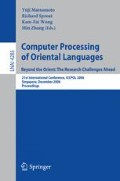Abstract
Japanese kanji recognition experiments are typically narrowly focused, and feature only native speakers as participants. It remains unclear how to apply their results to kanji similarity applications, especially when learners are much more likely to make similarity-based confusion errors. We describe an experiment to collect authentic human similarity judgements from participants of all levels of Japanese proficiency, from non-speaker to native. The data was used to construct simple similarity models for kanji based on pixel difference and radical cosine similarity, in order to work towards genuine confusability data. The latter model proved the best predictor of human responses.
Access this chapter
Tax calculation will be finalised at checkout
Purchases are for personal use only
Preview
Unable to display preview. Download preview PDF.
References
Apel, U., Quint, J.: Building a graphetic dictionary for Japanese kanji – character look up based on brush strokes or stroke groups, and the display of kanji as path data. In: Proceedings of the 20th International Conference on Computational Linguistics (2004)
Bilac, S., Baldwin, T., Tanaka, H.: Modeling learners’ cognitive processes for improved dictionary accessibility. In: Proceedings of the 10th International Conference of the European Association for Japanese Studies, Warsaw, Poland (2003)
Bilac, S., Baldwin, T., Tanaka, H.: Evaluating the FOKS error model. In: Proc. of the 4th International Conference on Language Resources and Evaluation, Lisbon, Portugal, pp. 2119–2122 (2004)
Eugenio, B.D., Glass, M.: The kappa statistic: A second look. Computational Linguistics 30(1), 95–101 (2004)
Fang, S.-P., Wu, P.: Illusory conjunctions in the preception of Chinese characters. Journal of Experimental Psychology: Human Perception and Performance 15, 434–447 (1989)
Feldman, L., Siok, W.: Semantic radicals contribute to the visual identification of chinese characters. Journal of Memory and Language 40, 559–576 (1999)
Feldman, L.B., Siok, W.W.T.: The role of component function in visual recognition of Chinese characters. Journal of Experimental Psychology: Learning, Memory and Cognition 23, 776–781 (1997)
Reips, U.-D.: Standards for internet-based experimenting. Experimental Psychology 49(4), 243–256 (2002)
Saito, H., Inoue, M., Nomura, Y.: Information processing of Kanji (Chinese characters) and Kana (Japanese characters). Psychologia 22, 195–206 (1995)
Saito, H., Masuda, H., Kawakami, M.: Form and sound similarity effects in kanji recognition. Reading and Writing 10(3-5), 323–357 (1998)
Taft, M., Zhu, X.: Submorphemic processing in reading Chinese. Journal of Experimental Psychology: Learning, Memory and Cognition 23, 761–775 (1997)
Taft, M., Zhu, X., Peng, D.: Positional specificity of radicals in Chinese character recognition. Journal of Memory and Language 40, 498–519 (1999)
van Heuven, W.J.B., Dijkstra, T., Grainger, J.: Orthographic neighborhood effects in bilingual word recognition. Journal of Memory and Language 39, 458–483 (1998)
Yeh, S.-L., Li, J.-L.: Role of structure and component in judgments of visual similarity of Chinese characters. Journal of Experimental Psychology: Human Perception and Performance 28(4), 933–947 (2002)
Author information
Authors and Affiliations
Editor information
Editors and Affiliations
Rights and permissions
Copyright information
© 2006 Springer-Verlag Berlin Heidelberg
About this paper
Cite this paper
Yencken, L., Baldwin, T. (2006). Modelling the Orthographic Neighbourhood for Japanese Kanji. In: Matsumoto, Y., Sproat, R.W., Wong, KF., Zhang, M. (eds) Computer Processing of Oriental Languages. Beyond the Orient: The Research Challenges Ahead. ICCPOL 2006. Lecture Notes in Computer Science(), vol 4285. Springer, Berlin, Heidelberg. https://doi.org/10.1007/11940098_33
Download citation
DOI: https://doi.org/10.1007/11940098_33
Publisher Name: Springer, Berlin, Heidelberg
Print ISBN: 978-3-540-49667-0
Online ISBN: 978-3-540-49668-7
eBook Packages: Computer ScienceComputer Science (R0)

